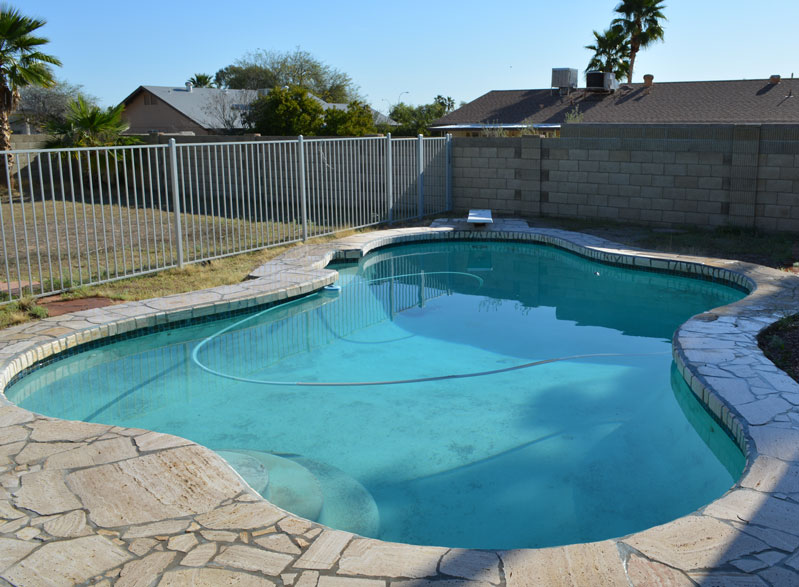
Living in an HOA community, even one started around 1971, requires us to keep our front yard looking sharp. Even with a desert landscaped yard, it means I have to occasionally face the Phoenix summertime inferno and engage in some dreaded yard work to avoid a friendly reminder in the mailbox and the judging, raised eyebrows of neighbors.
This time of year, with the horror of triple digit temperatures, yard work must be done like a commando strike, get in, get out,... and get on the couch with a frosty beverage.
I use whatever method I can to cheat and get done faster. If that means I forgo pulling weeds by hand and decimate them with a sweet, flame-throwing tool from my friends at Bernzomatic , then heck yeah! But more on that in a minute.
I'm going to share a few yardwork speed tips with you as I go. I realize not all my readers have desert landscapes, but these methods can be easily adapted elsewhere.

GET TO WORK!
It didn't help that I had really let it go for a while. To the delight of our expansive population of neighborhood rabbits, the mesquite tree had spent a great deal of its summer leisure time raining pale green seed pods on our landscape. They do an outstanding job of contrasting against the rocky yard to make it look extra scrubby and unkept. This is close combat work, to be picked up piece by individual piece.
SPEED TIP#1: Recruit Free Labor
I'm a big proponent of conscripted labor. Sweetie and I knew this particular clean up project was coming, so a little over 15 years ago, we took certain steps (that shall not be described here) resulting in a teenaged laborer. I love it when a plan comes together.
For this task, I supplemented our normal teenage conscripted workforce with a longer range labor plan that we'd started developing over 7 years ago. She was a little squirrely, but through wholesale bribery I was able to get her out to help.

LEAVES and SEED PODS
SPEED TIP#2: The Ol' Bucket Trick
Buckets aren't just for holding paint kids. For hand and knees precision cleanup, it's incredibly quick to use a 5 gallon bucket as a low- level transitionary vessel to a larger garbage can lined with a lawn waste bag.

AZ DIY Guy: Representing the two local big box stores equally.
Step one is done. Get out of the heat and prepare for battle another day.

TREES
The palms were overgrown and had to be trimmed. That was on tap for the next morning. It's actually quite fun, blazing through them with an electric pole saw. Close to the ground, it's unbelievably quick work.

As I shift to the taller trees, it's slightly less fun. Staring sunwards with sawdust and sharp, serrated palm fronds raining down on me while attempting to maintain solid ladder balance is a ripping good time.

Ehhh... still fun.
SPEED TIP#3: No delays with chainsaws, keep 'em running smooth
When using any sort of chainsaw for yard work tasks, add bar and chain oil, every chance you get , or even more often. I loose so much time when a chain heats up, expands, and slips off. Sometimes it damages it and I have to grind the drive teeth with a rotary tool to get it back in the saw sprocket. It's at least a half hour each time. A full oil reservoir just keeps me working instead of fixing the chain.

With bulk waste pickup a few weeks out, I lugged the fronds to a giant heap beside the house where they would wait, safely behind the fence.

WEEDS
Of course, next up was WEEDS.
I freaking hate weeding! In the land of very little rain, we still constantly have to fight weeds. The ones we get seem to be locked hard in the soil and are an incredible pain to pull out.
SPEED TIP#3: Fight weeds with a lawn and garden torch
Weeding does not have to be done on you hands and knees, or with nasty poisons, I propose we fight weeds with fire, my friends.
I used the Bernzomatic JT850 Lawn and Garden Torch, a lightweight, long-handled tool that looks like a steampunk walking cane. It's perfect for frying those devilish weeds.

The Lawn and Garden Torch
The nice thing about this beauty is that it uses the same propane bottle from a standard handheld torch, or the type used in a camping stove.

A long handled torch is absolutely wonderful for spot-killing weeds in non-combustible areas like desert landscaped yards, driveways or walkways, or stone-filled planting beds. I took it to the back yard first, to do some cleanup around the pool. After threading a bottle of propane onto the handle, I opened the valve, just a little bit to get the gas flowing. I found if I let too much out, it just won't light. There's a neat little sparking trigger built in, just to get the party started.

Auto start, no outside sparker needed!
I laid down some flames on the weeds that were taking root in the splash zone of the pool. This particular weed was more of a fine grass. The flame simply wiped it out in seconds. There was a slight crackle, a puff of smoke, and it was erased from the face of the earth.


The fine grass was super quick to wipe out, I strolled around the pool with the sun still low in the sky slaying weeds. It really didn't feel like work; it was relaxing and even a bit fun.
I think I can speak for all dudes when I say there is a vestige of man-child that lives in all of us. We never outgrow the desire to: A.) blow stuff up or B.) burn stuff down. Sure it's an irresponsible urge, that's why you don't see grown men melting plastic army men with a magnifying glass. But dang, when we're allowed to burn stuff?!!! Sign me up! (Ladies,...there's a vestige of man-child in you too. Try one of these out and you'll be hooked .)

How about those hearty, tenacious weeds that won't release their steely grip in the driveway or sidewalk cracks? They are those ugly suckers that break off when you try to pluck 'em, only to re-spout from the roots craftily left behind. I've got the solution...

Targeting,... targeting...
Ohhh heck yeah,..
FLAME ON!

Fire!
The moisture in the stem boils instantly to vapor and destroys the cells that let water travel through the plant. You can hear a satisfying, audible crackle as it happens. Nothing is coming back from those roots, Nothing,
Who's next?

Target destroyed.
I took a stroll along the front sidewalk, engaging in a light search and destroy. Luckily, there wasn't anything too serious to engage up there, just some tall, spindly-stalked stuff which met its end as I ambled along.
I think the ants I saw in the area must have something to do with keeping lush, leafy type stuff down, but I'm not sure. They're not fire ants, but still the little buggers are not averse to biting you on the toe knuckle if you tarry too long in their territory wearing sandals.

Towards the fence line, there was the big, lush stuff, the leafy, salad greens looking weeds. If anyone asks, I really threw my back into it and laboriously weeded the area. Yard work is brutal.

You can approach the lush, thick stalked stuff a couple ways. You can just kill it and let it dry out for a day or two before raking it up, or you can burn it to a crisp. Which will it be?
Option # 1 - Just kill the weed and let it dry: Generally, with the big stuff, especially in the back yard, I just hit it and come back later. Once the main stalk gets zapped, water cannot get to the rest of the weed. It won't survive and will just dry up. It's easy enough to rake up later.

Tick,.. tack,.. toe
Option #2 - Burn it to a cinder: If it's not too big, or if it's in an area you really want cleaned up right away, you can expend a little more propane and virtually vaporize it.
This rascal was a medium-sized growth, I could easily wipe out in a few seconds.

I kicked the dried, flammable sticks and leaves from the area and laid down some flame upon the interloping weed.

After about 30 seconds of heat, the weed was pretty much reduced to crispy ash. Seriously, you can't tell me this doesn't look like fun.

A quick touch up with a landscaping rake cleans up the ash and smooths the ground out a bit.

The weeds never existed. I was never here. You didn't see anything. Go back to your drink.

Some safety tips:
- I shot most of these photos in low light and shadows. Still, notice how difficult the flame is to see. Watch where you point this rascal. There can be 8 - 12" of flame you cannot see, especially in brighter light. It would be easy to set something on fire by mistake.
- Take extra care around plants you don't want to kill. I have a buddy that murdered his shrubs by letting the flame lick at their stems for a few moments. His wife was not pleased.
- This is seriously not flipflops or sandals work, especially with near invisible flame. I recommend wearing boots. There were a couple times I missed a small leaf of twig which then caught fire. I stomped those out before moving on. Boots are good.
- Keep your head on a swivel and mind your surroundings. Watch for flame ups where you don't want them. Make sure there is not anything smoldering before you leave an area. When in doubt, squirt the area with a hose.
- Keep a fire extinguisher nearby, or at least a garden hose.
- If you go time-traveling and end up facing one of those nasty, Victorian villains with a sword-cane and a twirled moustache, I heartily recommend lighting up this flame thrower cane while they are still pontificating. They'll never expect it.
- Don't torch weeds in your best clothes before a meeting with your priest, pastor, children's teacher, or boss. While any of the weeds may leave a slight burnt aroma on your clothes, others leave a definitively wacky scent, a scent I remember smelling in the area of lawn seats of certain rock concerts of my youth. Probably not an impression you want want folks to have of you.
That's it. The Bernzomatic JT850 Lawn and Garden Torch helped effortlessly wrap up the cleanup. I just can't help myself. I just keep going out and flaming other parts of the yard, whenever I see a few weeds crop up,
Flame on my friends.


This is a sponsored post. I am a proud to be a Bernzomatic Torch Bearer, though all opinions expressed are 100% my own. I won't recommend products I don't believe in.
The Torch Bearers are a group of tradespeople, DIYers, culinarians, adventurers and artists brought together to create projects using Bernzomatic torches and share their knowledge and ideas with you. Check them out here and get inspired to create with fire.

No ants were harmed in the making of this post, except perhaps a few of those toe-knuckle biting suckers, but they deserved it.






































































